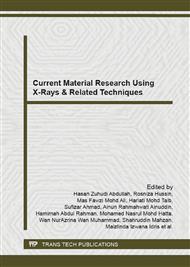[1]
Jeon, H.-J., Yi, S.-C., & Oh, S.-G., Preparation and antibacterial effects of Ag–SiO2 thin films by sol–gel method. Biomaterials, (2003). 24(27), 4921–4928
DOI: 10.1016/S0142-9612(03)00415-0
Google Scholar
[2]
Tiller, J. C., Liao, C. J., Lewis, K., & Klibanov, A. M., Designing surfaces that kill bacteria on contact. Proceedings of the National Academy of Sciences of the United States of America, (2001). 98(11), 5981–5
DOI: 10.1073/pnas.111143098
Google Scholar
[3]
Ohira, T., Kawamura, M., Fukuda, M., Alvarez, K., Özkal, B., & Yamamoto, O., Extension of the Optical Absorption Range in Zn-Doped MgO Powders and Its Effect on Antibacterial Activity. Journal of Materials Engineering and Performance, (2009), 19(3), 374–379
DOI: 10.1007/s11665-009-9490-y
Google Scholar
[4]
Bonetta, S., Bonetta, S., Motta, F., Strini, A., & Carraro, E., Photocatalytic bacterial inactivation by TiO2-coated surfaces. AMB Express, (2013),3(1), 59
DOI: 10.1186/2191-0855-3-59
Google Scholar
[5]
Jain, N., Gupta, R., Rai, R. K., & Ray, S. S., Anti-microbial activity of TiO 2 micro-particles in suspension on E . coli strains under UV irradiation Introduction , (2012). 1(1), 21–30.
DOI: 10.9790/3008-0112130
Google Scholar
[7]
Atkinson, I., Teoreanu, I., Mocioiu, O. C., Smith, M. E., & Zaharescu, M., Structure property relations in multicomponent oxide systems with additions of TiO2 and ZrO2 for glaze applications. Journal of Non-Crystalline Solids, (2010), 356(44-49), 2437–2443. doi:10.1016/j.jnoncrysol. 2010.04.054
DOI: 10.1016/j.jnoncrysol.2010.04.054
Google Scholar
[8]
Folli, A., Pochard, I., Nonat, A., Jakobsen, U. H., Shepherd, A. M., & Macphee, D. E., Engineering Photocatalytic Cements: Understanding TiO2 Surface Chemistry to Control and Modulate Photocatalytic Performances. Journal of the American Ceramic Society, (2010), 93(10), 3360–3369
DOI: 10.1111/j.1551-2916.2010.03838.x
Google Scholar
[9]
Zhang, Feng Chen, Weiwei Zou & Wenwu Qu, Photocatalytic performance of a visible light TiO2 photocatalyst prepared by a surface chemical modification process. Catalysis Communications (2009).
DOI: 10.1016/j.catcom.2009.04.005
Google Scholar


